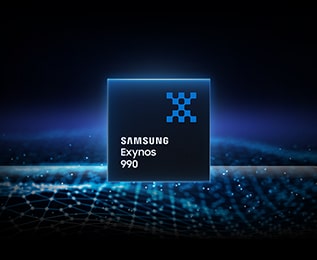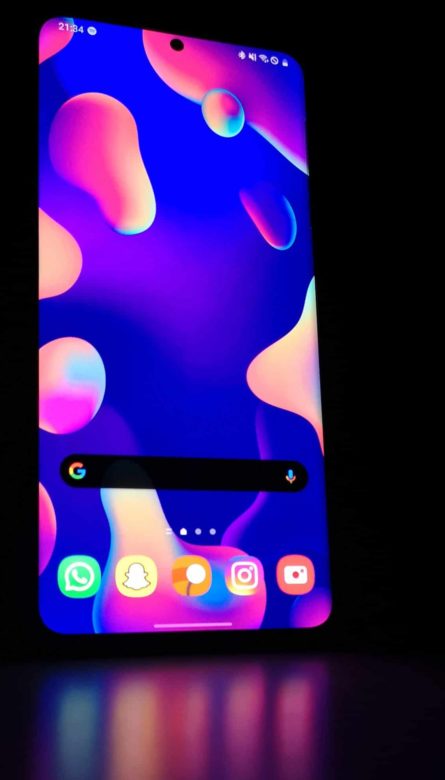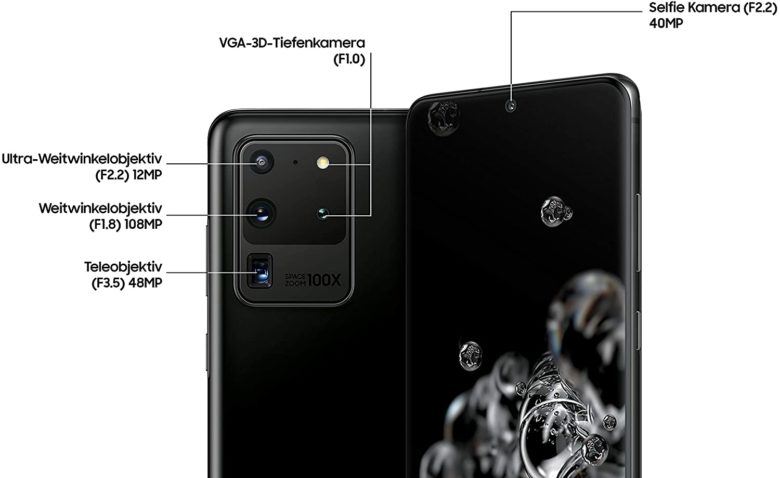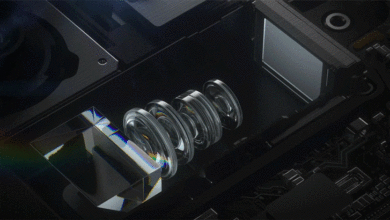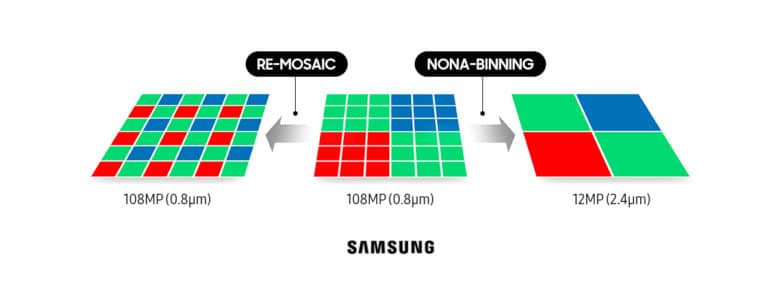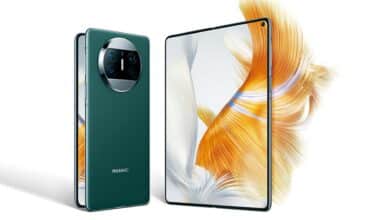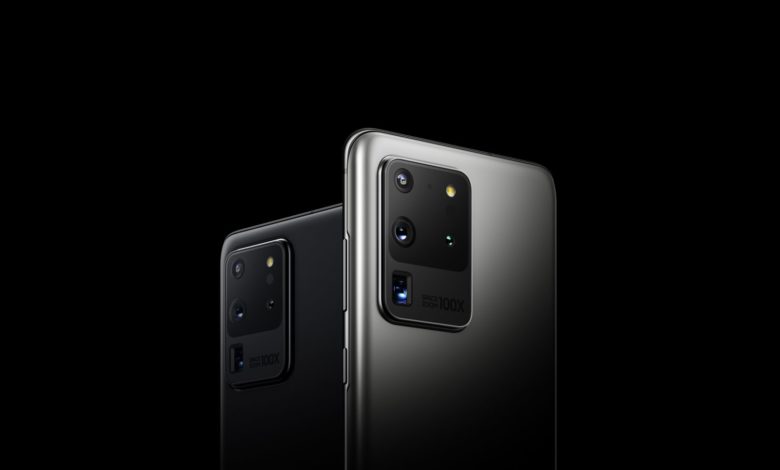
This year, Samsung has launched another device in its Galaxy S series in addition to the S20 and S20 Plus: the Galaxy S20 Ultra. As the name suggests, Samsung is positioning the S20 Ultra as the “Ultra-Flagship”. It should be the best Samsung has to offer at this time.
Here I will give an overview of what the Ultra flagship of the world’s largest smartphone manufacturer has to offer and if it is a good choice.
Workmanship and design
As you would expect from Samsung, the Galaxy S20 Ultra is also beautifully finished. The front is clean and symmetrical. The 40 megapixel selfie camera in the tiny punch hole is located in the middle upper edge of the display.
Originally, Samsung was the trendsetter for the Edge display, which is rounded at the sides, but they have now built a fairly flat display into this year’s Galaxy-S phones, which I find a welcome change.
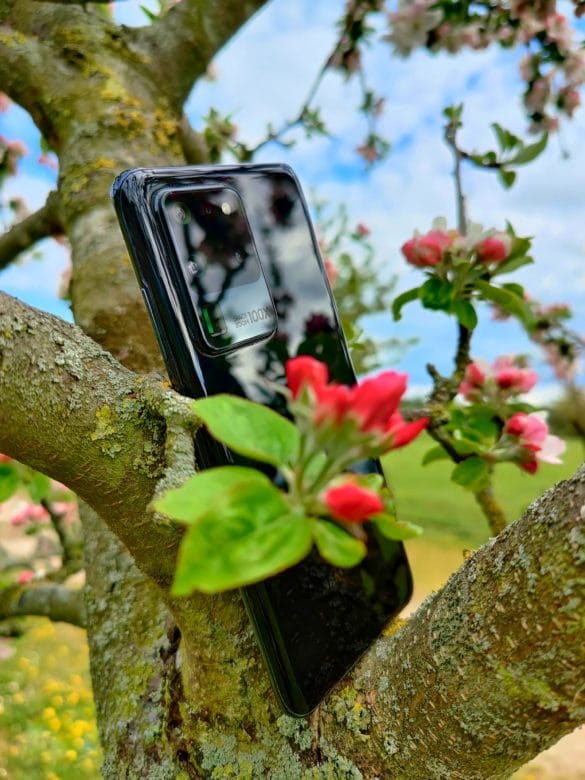
With a screen diagonal of 6.9 inches and a thickness of 8.8 mm, the Galaxy S20 Ultra is one of the largest smartphones currently available on the market and is not exactly the most handy device. Therefore, it is probably less suitable for people with small hands and people who like to use their phone one-handed. However, as a fan of large smartphones, I like it very much.
The glass back is available in Cosmic Black, Cosmic Gray and Cloud White and, unlike the display, bends around the sides of the device where the thin aluminium frame is located. At the top left of the back is the solid camera module with four different lenses, which allows you to recognize the S20 Ultra from a long distance.
All in all, I think the design of the S20 Ultra is really well done and, in terms of looks, my favourite so far this year.
Hardware and Specsheet
SoC
Here in the EU, under the hood of the Galaxy S20 Ultra is the Exynos 990, Samsung’s latest in-house SoC. At its side are a whole 12/16 GB RAM, as well as 128 GB or 512 GB fast UFS 3.0 memory. This puts the S20 Ultra at the forefront in terms of performance, similar to a OnePlus 8 Pro, which uses Snapdragon 865. But I didn’t expect anything else from a premium unit like the S20 Ultra. To make all this power and especially the energy hungry display possible, a 5.000 mAh battery is built into the S20 Ultra.
One little thing that I find disturbing is that there are two versions of the Galaxy S20 Ultra. The EU version with the Exynos 990 and the US version with the Snapdragon 865, but in terms of performance and energy efficiency, the Snapdragon is superior to the Exynos in the S20 Ultra. The US variant should offer about 10% more performance in the benchmark, as well as about 2 hours more screen-on-time (source: Notebookcheck). It is a pity that the version with the Snapdragon is not available in the EU and the price is still identical.
Due to the current Corona pandemic, I was not able to test the 5G functionality of the Galaxy S20 Ultra, because there is no 5G reception at home.
Display
On the front of the Galaxy S20 Ultra is a 6.9-inch “Quad HD+ Dynamic AMOLED 2X Infinity-O Display”, as Samsung calls it. This makes it the most rimless front of a smartphone I’ve ever seen in person.
The panel itself plays in the absolute top class of currently available smartphone displays. 120 Hz refresh rate is a game changer compared to last year’s 60 Hz. In my opinion, a higher refresh rate like 90 or 120 Hz is an absolute must for anyone who wants to get a new smartphone this year, as it gives a completely different feeling of the phone’s power. Comparable to an HDD to an SSD in a PC.
The colour reproduction of the display is also great, as you would expect from Samsung. Crisp colours, thanks to HDR10+, in dark or bright lighting conditions. As well as very sharp 1440p or a pixel density of 511 ppi at 60 Hz. At 120 Hz, on the other hand, only a Full-HD resolution so far. This is enough for me personally. I don’t see too much difference between Full-HD and 1440p and prefer to profit from the higher battery life of the lower resolution. This is also the case with my Daily-Driver, the OnePlus 8 Pro, where 120 Hz and 1440p are possible at the same time. Nevertheless, it’s quite likely that Samsung will enable QHD + 120Hz in a future update.
Specsheet
| Device | size | 166.9 x 76 x 8.8 mm |
|---|---|---|
| weight | 220 g | |
| material | glass front (Gorilla Glass 6), glass back (Gorilla Glass 6), aluminium frame | |
| SIM | Single SIM (Nano SIM and/or eSIM) or Hybrid Dual SIM (Nano SIM, dual stand-by) | |
| security | IP68 Dust/water resistant (up to 1.5m for 30 min) | |
| colours | Cosmic Grey, Cosmic Black | |
| Display | type | Dynamic AMOLED 2X, 16M colors |
| size | 6.9 inch, 114.0 cm2 (~89.9% screen-to-body ratio) | |
| resolution | 1440 x 3200 pixels, 20:9 ratio (~511 ppi density) | |
| protection | Corning Gorilla Glass 6 | |
| Extras | HDR10+ Always-on display 120Hz@FHD/60Hz@QHD Frame rate |
|
| Platform | operating system | Android 10, One UI 2 |
| chipset | Exynos 990 (7 nm+) (EU) | |
| CPU | Eight core (2×2.73 GHz Mongoose M5 & 2×2.50 GHz Cortex-A76 & 4×2.0 GHz Cortex-A55) (EU) | |
| GPU | Mali-G77 MP11 (EU) | |
| Memory | Extendable | microSDXC (uses shared SIM slot) |
| internal | 128GB/512GB memory, 12GB RAM | |
| type | UFS 3.0 | |
| Main camera | quad | 108 MP, f/1.8, 26mm (Normal), 1/1.33″, 0.8µm, PDAF, OIS 48 MP, f/3.5, 103mm (periscope telephoto), 1/2.0″, 0.8µm, PDAF, OIS, 4x optical zoom, 10x hybrid zoom 12 MP, f/2.2, 13mm (ultra wide angle), 1.4µm, Super Steady Video 0.3 MP, TOF 3D, f/1.0, (depth sensor) |
| Features | LED Flash, Auto-HDR, Panorama | |
| video | 8K@24fps, 4K@30/60fps, 1080p@30/60/240fps, 720p@960fps, HDR10+, Stereo Sound Recording, Gyro-EIS & OIS | |
| Selfie camera | Dual | 40 MP, f/2.2, 26mm (Normal), 0.7µm, PDAF |
| Features | Dual Video Call, Auto-HDR | |
| video | 4K@30/60fps, 1080p@30fps | |
| Audio | Loudspeaker | Dual Stereo Speakers |
| 3.5mm AUX | no | |
| Extras | 32-bit/384kHz Audio Tuned by AKG |
|
| Communication | WLAN | Wi-Fi 802.11 a/b/g/n/ac/ax, Dual-Band, Wi-Fi Direct, Hotspot |
| Bluetooth | 5.0, A2DP, LE | |
| GPS | Yes: A-GPS, GLONASS, BDS, GALILEO | |
| NFC | Yes | |
| USB | 3.2, Type-C 1.0, USB On-The-Go | |
| mobile | 5G/4G/3G/2G | |
| Features | Sensors | fingerprint (in display, ultrasonic), acceleration, gyro, proximity, compass, barometer |
| Extras | ANT+ Bixby Samsung DeX |
|
| Battery | type | Not removable Li-Po 5000 mAh battery |
| charge | Quick charging with 45W USB Power Delivery 3.0 Fast Qi/PMA wireless charging 15W Power Bank/reverse wireless charging 9W |
Multimedia
Streaming video on the S20 Ultra is a dream come true. Thanks to the borderless display, you hold the film in your hands, so to speak. The size of the Galaxy S20 Ultra is also an advantage when watching videos. So no details remain undiscovered. What’s more, the Galaxy S20 Ultra has been “HDR certified” by Netflix, which means that HDR content can be played on the phone via Netflix. The punch hole for the front camera does not bother me personally.
The Galaxy S20 Ultra’s loudspeakers are also convincing in every respect. The sound is very clear and the bass sounds natural for such small speakers. Moreover, the loudspeaker gets really loud. The earcup serves as the second speaker in the stereo setup. This and the speaker on the underside of the phone produce a balanced sound field, so you don’t get the feeling that one ear is exposed to more sound than the other.
Performance
Benchmarks
The S20 Ultra does very well in the “Geekbench” and “3D Mark” benchmarks. The Exynos 990 is here only slightly inferior to the Snapdragon 865 in the OnePlus 8 Pro, which I used as a comparison device.

Every-Day-Experience
The Galaxy S20 Ultra flies through all sorts of tasks that you can put in its way. The UFS 3.0 memory and 12/16 GB RAM make multitasking a snap for the S20 Ultra and loading times are short. In addition, the 120 Hz display, which paired with the Exynos 990 allows extremely smooth scrolling, for example in social media apps. Games, such as PUBG Mobile, can also be played on the highest settings and at a good frame rate.
Camera
The camera is obviously the feature on the Galaxy S20 Ultra that Samsung has put the most emphasis on and which is most promoted. This is also shown by the prominence of the camera module on the back of the device. With a total of five different sensors, the S20 Ultra is equipped with photo power right down to the teeth.
Back module
On the back you find the 108 MP main camera, which can take such high resolution photos that you can zoom in afterwards and theoretically print the photo on a poster, which would still be super sharp. The second thing that stands out is the periscope telephoto camera. Here, the sensor was built into the side of the phone, making a fourfold optical zoom possible with several lenses and a prism. This camera can record at up to 48 MP. The last real camera on the back is the Ultrawide camera. It records with 12 MP and is great for taking pictures of buildings or landscape. Last but not least you will find a time-of-flight sensor on the back. This sensor allows the S20 Ultra to accurately estimate distances to objects, which makes the depth of field in photos look realistic.
Zoom
In general, however, the cameras and sensors on the back should not be viewed individually, but as a complete system. This is how Samsung advertises the “100X Space Zoom”, which is made possible by the combination of the periscope telephoto camera and the other sensors. But unfortunately I have to say that the “100X Space Zoom” actually only serves a pure advertising purpose. Yes, it is possible to zoom 100X with the Galaxy S20 Ultra, but at the latest from 50X on the image looks so blurred and blurred that it is practically impossible to use it.
On advertising posters “100X Space Zoom” sounds great of course, but unfortunately it is useless in practice. Otherwise, the zoom of the S20 Ultra is a dream. Each zoom level between 1x and 10x results in practically lossless photos, which makes the camera extremely versatile.
108 MP Sensor
Thanks to the 69 mm2 large 108 MP sensor, the Galaxy S20 Ultra can capture a lot of light even in low light conditions. For this purpose Samsung has come up with the so-called “Nona-Binning”. Here, 9 pixels are practically combined into one large pixel, which thus has more surface area and can capture more light. This allows better photos, especially in dark light conditions. By default, this feature is activated in the camera and is only switched off when you switch to 108 MP mode. This means that the normal photo size of the S20 Ultra 12 MP is still sharp and sufficient for all kinds of social media services.
The size of the sensor has another aspect, which is both an advantage and a disadvantage. On the one hand, the size allows for a lot of natural depth of field, on the other hand, the focal plane is sometimes a little small and parts of the image that you want to have in focus are blurred. Just like the edges of the photo. However, this is only a small thing and even pleases many people, as it gives the photo a unique look.
Here is an example of a 108 MP photo. To keep the full quality I have packed the picture in a .zip file.
Front camera

With its 40 MP, the front camera captures even the finest details of the face. With the help of HDR, the images are always perfectly illuminated, even in backlight conditions. What I also think is very good is that Samsung has decided to install a wide-angle lens in the front camera, so that it is easier to get several people in one photo.
Video
The Galaxy series also supports 8K video since this generation. This is 16 times as many pixels as the average movie projected onto the screen. However, the whole thing is still in its infancy and more of a gimmick. To make 8K video look good, you need bright light and a steady hand, as there is hardly any stabilization in the video. In addition, the video always looks a bit zoomed in, which means that you have to move a bit further away from the object you want to film.
4K-30 fps and 4K-60 fps on the other hand are really well done. The optical and software-based image stabilization work together formidably to enable a smooth image flow. In combination with the support of HDR in moving images, the S20 Ultra’s videos always look very good. There is also a so-called “Super Steady” mode, in which the image stabilization can be increased to a maximum, making the video incredibly stable even when running. I don’t have any complaints about the S20 Ultra’s microphones either. The sound is clear, natural and full, and voices sound extremely pleasant.

Special features
Of course, Samsung hasn’t forgotten to give the Galaxy S20 Ultra some cool features. For example, the night mode, which is already part of the scope of delivery of every new smartphone, is not missing. In this mode, the phone takes several pictures over a few seconds, which are then offset against each other to create a brighter picture. There is also Samsung’s own “single take” mode in the camera app. The “single take” mode simultaneously records videos and photos within the triggered time, from which an artificial intelligence suggests which ones have become the best. In addition, there is a slow-motion function that allows you to record a short moment with up to 960 fps.
Battery
The Galaxy S20 Ultra is powered by a 5,000 mAh battery, which is a real house number for a smartphone. In comparison, an iPhone 11 Pro, for example, only has a 3,000 mAh battery, or a Huawei P40 Pro has a 4,200 mAh battery. However, the huge 120 Hz display is a real battery eater, which makes the battery life not superior to other phones with smaller batteries.
With the Galaxy S20 Ultra, I always got through the day well thanks to the generous battery, sometimes even up to two days. I had an average screen-on-time of seven to eight hours, which in my understanding is a good battery life for today’s smartphones. However, the EU variant unfortunately cannot keep up with the US variant in terms of battery life. This one is supposed to offer about 2 hours more screen-on-time, which is with 10 hours or more breathtakingly long and I would have wished for the EU variant as well.
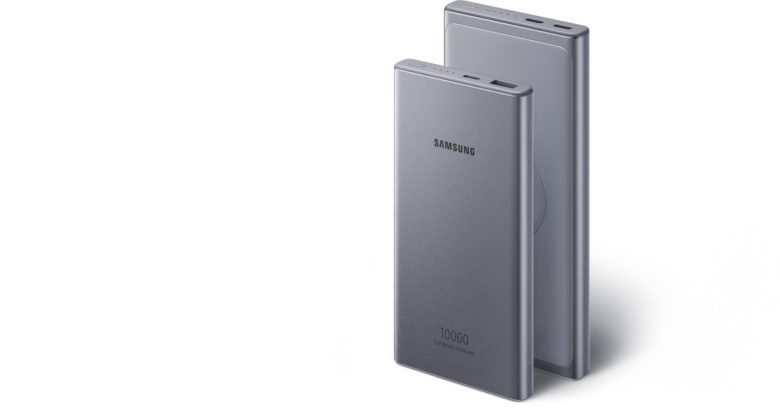
However, the battery of the Galaxy S20 Ultra is quickly recharged. Thanks to the included 25 watt power supply, about 55% in half an hour and from 0% to 100% in just under an hour. It is also possible to charge the S20 Ultra with up to 45 watts. You’ll have to buy the appropriate adapter from Samsung for this, though. Wireless charging is of course also possible. With up to 15 watts with the Wireless Charger from Samsung.
Price-performance ratio
With a starting price of 1349 €, or a current price of € 1,379.00 , the Galaxy S20 Ultra is not exactly a bargain. However, the intention of Samsung behind the Galaxy S20 Ultra was not to appeal to the average smartphone user. The S20 Ultra is the premium device of Samsung’s flagship line-up, the S20 series. With the Galaxy S20 Ultra, Samsung wants to appeal to smartphone enthusiasts who get a lot of value out of their phone and are therefore willing to spend more money on their phone, as well as customers who are actually considering buying a camera. In this respect, Samsung has also done a lot of marketing, as can be seen from the marketing of the S20 Ultra camera. In this respect, the Galaxy S20 Ultra is much more of a smartphone-camera hybrid than a smartphone with camera functionality.
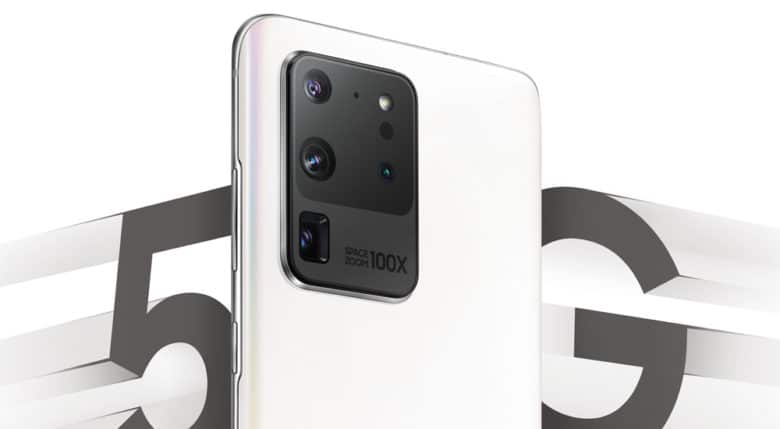
Nevertheless, crossing the 1000 Euro hurdle for a smartphone is a strong step. The phone must also offer something extraordinary to justify this step. In this respect, I must honestly say that the S20 Ultra does this. The camera is really an absolute all-rounder and has practically no weaknesses. Every photo looks good, regardless of the lighting or other conditions. Each of the four cameras is extremely solid. Add to this the beautiful 120 Hz display and the huge battery and you have the Galaxy S20 Ultra in every aspect a complete ultra-flagship. Nevertheless, there are of course alternatives where you can save a few hundred euros with a few cuts. See: Xiaomi Mi 10 Pro for
Summary
All in all, the Samsung Galaxy S20 Ultra is an absolute all-rounder. There’s almost nothing you could ask for in a smartphone that the S20 Ultra doesn’t have. A super nice, fast and sharp display. A camera that can cinematically capture any situation, and a top performance that will appeal to power users and mobile gamers.
Of course, the Galaxy S20 Ultra is not perfect, and there are a few little things that could be improved, but overall I can recommend the Galaxy S20 Ultra to anyone who is willing to spend over 1000 € (at the time of writing) for a smartphone.
Samsung Galaxy S20 Ultra 5G
Workmanship and design
Hardware
Multimedia
Performance
Camera
Battery
Value for money
94/100
Ultra means Ultra here too! A befitting top smartphone and in my opinion the current King of Android.


